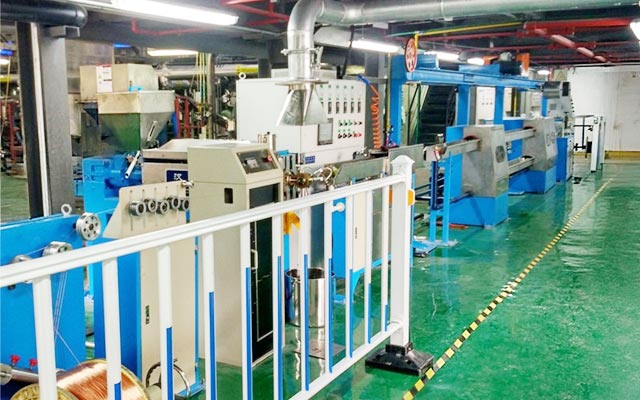Model 30-90Screw Diameter φ30-φ90L/D Ratio 25:1Extrusion Output 15-70 kg/hrMain Motor 30-55 kWOutlet Diameter 0.25-50 mmSpeed 400 m/minApplication FEP/FPA/ETFE/PTFE cable.
ETFE Cable Extrusion Line
The ETFE high-temperature cable extrusion production line is a high-precision system specifically designed for processing ethylene-tetrafluoroethylene copolymer (ETFE) insulated cables. As a high-performance fluoroplastic, ETFE combines excellent mechanical strength, chemical corrosion resistance, radiation resistance, and flame retardancy, with a continuous service temperature range of -150°C to +150°C. Through melt extrusion technology, this production line forms a thin-walled, uniform insulation layer on the conductor surface, making it suitable for applications demanding extreme mechanical durability and environmental reliability.
Core Value:Enables lightweight and thin-walled cable manufacturing (insulation layer thickness can be below 0.2mm);
Meets stringent requirements for radiation resistance and long-term reliability in aerospace, nuclear power plants, and military equipment;
Enhances production efficiency and reduces overall costs through high-speed extrusion.
Components
A complete ETFE high-temperature cable extrusion production line typically consists of the following key units connected in series:
Unwinding Pay-OffUsed to hold and unwind the metal conductor (copper wire) spool, providing stable and controllable tension to prevent wire thinning or breakage.
Pre-HeaterPreheats the conductor before it enters the cross-head. This helps remove moisture and oil contamination from the conductor surface and raises its temperature, promoting better adhesion between the molten Teflon material and the conductor, reducing internal stress, and improving product quality.
High-Temperature ExtruderHeats and melts thermoplastic Teflon pellets (e.g., FEP/PFA), then compresses, plasticizes, and conveys them to the cross-head via the rotation of the screw.
Features:
High-Temperature Design: The barrel and screw must be made from special alloys (e.g., Inconel) to withstand the high-temperature processing environment of 380°C - 420°C.
Precision Temperature Control: The barrel is divided into multiple zones, each independently and precisely controlled by a PID system to ensure uniform and stable melting of the material.
Screw Design: Features a large length-to-diameter ratio (L/D), providing excellent plasticizing capability and stability.
Extrusion Cross-Head and DieGuides the molten Teflon to uniformly and concentrically coat the continuously passing conductor.
Cooling Water TankImmerses the wire with the newly applied molten insulation layer into cooling water to rapidly solidify and set its shape. The water temperature usually requires constant control to ensure stable product performance.
Laser Diameter GaugeMonitors the outer diameter of the insulation layer in real time and feeds the data back to the capstan or extruder speed control system, enabling closed-loop control to ensure extremely stable outer diameter tolerance.
High-Voltage Spark TesterApplies thousands of volts of high voltage to the wire. Any pinholes or defects in the insulation layer will cause a breakdown and immediate alarm, ensuring 100% defect-free products.
Eccentricity GaugeDetects whether the insulation layer is applied uniformly and checks for concentricity.
Capitstan / Puller: Provides smooth pulling force to draw the cable from the unwinding end through the entire production line to the take-up end. Its speed must be precisely synchronized with the extrusion speed, directly affecting the thickness and uniformity of the insulation layer.
Take-Up SpoolWinds the finished wire neatly onto a spool. The take-up tension must remain constant to avoid damaging the wire or causing loose winding.
Control SystemIntegrates a PLC (Programmable Logic Controller) and a touchscreen HMI (Human-Machine Interface) to centrally control all parameters of the entire production line (speed, temperature, tension, etc.), enabling automated production, data recording, and fault diagnosis.
Process Flow
Pay off -> Conductor Preheating -> High-Temperature Melt Extrusion & Coating -> Water Cooling & Setting -> Online Diameter Measurement & Spark Testing -> Pulling -> Take-Up.
ETFE Cable Extrusion Line Datasheet
| Model |
30 |
35 |
45 |
65 |
90 |
| Screw Diameter (mm) |
φ30 |
φ35 |
φ45 |
φ65 |
φ90 |
| Screw L/D Ratio |
25:1 |
25:1 |
25:1 |
25:1 |
25:1 |
| Temperature Control |
6 segment |
6 segment |
6 segment |
7 segment |
9 segment |
| Extrusion Amount (kg/hr) |
15 |
20 |
25 |
45 |
70 |
| Outlet Wire (mm) |
0.25-2.5 |
0.6-3.0 |
0.8-5.0 |
2.0-10.0 |
8.0-50.0 |
| Total Power (KW) |
30 |
32 |
40 |
55 |
/ |
ETFE Cable Extrusion Line Application
The ETFE high-temperature cable extrusion production line is a critical link in high-end equipment manufacturing. The cables it produces, characterized by lightweight design, radiation resistance, and high reliability, serve as the "blood vessels and nerves" in aerospace, nuclear industry, new energy vehicles, and other advanced fields. Compared to PTFE/FEP, ETFE offers significant advantages in mechanical strength and processing efficiency, bridging the performance gap between traditional fluoroplastics and engineering plastics. Its primary applications include:
AerospaceAircraft wiring harnesses, satellite cables, radiation-resistant connectors for spacecraft. ETFE is the only fluoroplastic that combines lightweight properties, radiation resistance, and high mechanical strength.
Nuclear IndustryMonitoring cables for nuclear reactors, control cables for nuclear power plants, wiring for sensors in irradiated environments. *Its γ-ray resistance (>10⁶ Gy) far exceeds that of PTFE/FEP.*
New Energy VehiclesHigh-voltage wiring harnesses for battery packs, motor winding wires, charging station cables. Resists high temperatures, flame retardant, and resistant to vibration fatigue.
Military EquipmentCables for armored vehicles, ship wiring, field communication equipment cables. Resists oil contamination, impact-resistant, and operable across a wide temperature range.
Architectural Membrane StructuresConductive membrane cables for smart buildings, sensing wires for tensile structures. High transparency and excellent weldability.


